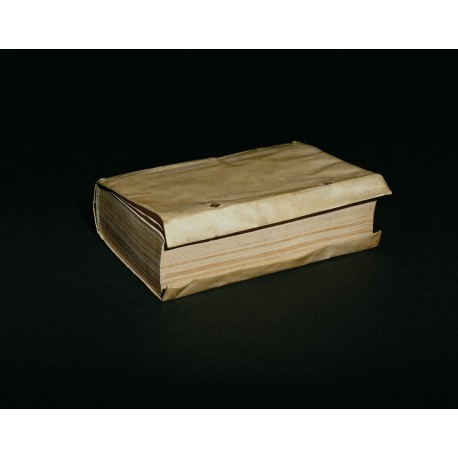 View larger
View larger
De curandi ratione libri octo causarum signorumque catalogum breuiter continents, partim olim conscripti, & nunc postremùm recognit, multisque locis aucti: partim recens adiecti… Accessit quoque locuples rerum & uerborum memorabilium Index
- Subjects
- Medical books - Early works to 1800
- Authors/Creators
- Fuchs, Leonhart, 1501-1566
- Printers/Publishers
- Oporinus, Johann, active 1536-1567
- Owners
- Augustiner-Chorherrenstifts Baumburg an der Alz
- Other names
- Christoph, Duke of Württemberg, 1515-1568
Fuchs, Leonhart
Wemding 1501 – 1566 Tübingen
De curandi ratione libri octo causarum signorumque catalogum breuiter continents, partim olim conscripti, & nunc postremùm recognit, multisque locis aucti: partim recens adiecti… Accessit quoque locuples rerum & uerborum memorabilium Index.
Basel, Johann Oporinus, 1568 (i.e . 1548?)
octavo (166 × 105 mm), (392) ff. signed a8 a–z8 aa–zz8 Aa–Bb8 and paginated (16) 1–727 (i.e. 735) and (33)pp. index. Eight full-page woodcut illustrations of surgical instruments printed with the text (folios nn5 verso through oo1 recto), but not included in pagination; and another, smaller woodcut (folio zz5 recto).
provenance Augustiner-Chorherrenstifts Baumburg an der Alz, title inscribed Monasterij Baumburg — reputedly acquired by the Universitätsbibliothek München and sold as a duplicate — ‘Aus dem Nachlaß eines Münchner Arztes’, sale by Hartung & Hartung, Auktion 66, Munich, 5 November 1991, lot 126 — Reiss & Sohn, Auktion 118, Königstein im Taunus, 22 April 2008, lot 1110
In faultless state of preservation.
binding contemporary flexible vellum, remnants of silk ties.
A fine copy of Fuchs’ handbook of therapeutics, here in its final form incorporating the author’s last additions and revisions.
The work has a complex textual evolution, being several times revised, enlarged, and corrected by the author. It developed from a book on therapies, De Medendis singularum humani corporis partium libri quatuor, published at Basel in 1539, immediately after Fuchs completed his Greek edition of Galen. A fifth part, ‘De medendis tumoribus praeter naturam’, was appended in 1542, when the book was reprinted by Johann Oporinus under the new title De Sanandis totius humani corporis libri quinque.1 Three further parts were prepared for the present edition, when the work assumed yet again a new title. These new parts (Books vi–viii) discuss the treatment of wounds, tumours, ulcers, fractures and dislocations, and are illustrated by woodcuts of surgical instruments copied (with acknowledgement) from Jean Tagault’s De chirurgia institutione (1543), itself a rewriting of Guy de Chauliac.
The ‘Epistola nuncupatoria’ in our volume is addressed to Christoph, Herzog von Württemberg (1515–28 December 1568), and is dated by Fuchs at Tübingen, 1 March 1548. In the preface, Fuchs states that he had been urged by Oporinus to prepare a new edition, since the stock of the previous edition (the aforementioned De Sanandis totius humani of August 1542) had been exhausted.2 The colophon, however, reads ‘Basileae, per Ioannem Oporinum, Anno salutis humanae mdlxviii Mense Martio’. In all bibliographies, ‘1568’ is regarded as the date of publication; the ‘first edition’ of the text is considered to be the one printed at Lyon by Guillaume Rouillé, with a colophon dated March 1548.3
In our judgment, the numeral ‘x’ was transposed by Oporinus’ compositor, and the colophon misprinted as 1568 instead of 1548. Although no ‘1548’ edition appears in the Oporinus shop catalogue of 1552, a work conforming to it is listed in Gesner’s Appendix Bibliothecae published at Zürich in 1555: ‘Praeterea libros quinque de medendi ratione recognouit & auxit, additis tribus libris chirurgicis. Basileae impressit Oporinus’ (folio n3 verso). Further doubt on ‘1568’ as the date of issue is cast by the documents of the press, which indicate that Johann Oporinus had sold the business to his brother Hieronymus in 1567, some six to eight months before his death on 6 July 1568.4
references Johann Karl Proksch, Die Litteratur über die venerischen Krankheiten (Bonn 1889), p.102; Eberhard Stübler, Leonhart Fuchs Leben und Werk (Munich 1928), pp.222–225 and no. 35a (woodcut reproduced p.59); Richard J. Durling, Catalogue of sixteenth century printed books in the National Library of Medicine (Bethesda 1967), no. 1694; Verzeichnis der im deutschen Sprachbereich erschienenen Drucke des xvi. Jahrhunderts (Stuttgart 1986), F–3254; John L. Heller and Frederick G. Mayer, ‘Chronological List of the Published Works of Leonhart Fuchs and Cognate Works’ in The great herbal of Leonhart Fuchs: De historia stirpium commentarii insignes, 1542 (notable commentaries on the history of plants), Vol.1, Commentary (Stanford, ca 1999), p.693 no. 88
1. Heller and Mayer, op. cit., i, pp.665–666 no. 32.
2. The relevant passage is transcribed by Stübler, op. cit., no. 34.
3. Henri Louis Baudrier, Bibliographie lyonnaise (Lyon 1895–1921), ix, p.143; Durling, op. cit., no. 1691; Heller and Mayer, op. cit., i, pp.691–692 no. 83.
4. Martin Steinmann, Johannes Oporinus: Ein Basler Buchdrucker um die Mitte des 16. Jahrhunderts (Basel & Stuttgart 1967), p.114.



